Automatic Early Warning to Derive Eruption Source Parameters of Paroxysmal Activity at Mt. Etna (Italy)
Abstract
1. Introduction
2. Etna Paroxysmal Activity
3. Early-Warning Systems
3.1. Infrasonic System (IS)
3.2. Thermal Camera (TC)
3.3. Weather Radar (WR)
4. Application to Etna
4.1. 10 April 2011
4.2. 12 April 2012
4.3. 23 November 2013
4.4. 3–5 December 2015
4.5. 16 and 23 February 2021
5. Combined Approach for Paroxysmal Early Warning
6. Conclusions
Author Contributions
Funding
Data Availability Statement
Acknowledgments
Conflicts of Interest
References
- Jenkins, S.F.; Barsotti, S.; Hincks, T.K.; Neri, A.; Phillips, J.C.; Sparks, R.S.J.; Sheldrake, T.; Vougioukalakis, G. Rapid emergency assessment of ash and gas hazard for future eruptions at Santorini Volcano, Greece. J. Appl Volcanol. 2015, 4, 16. [Google Scholar] [CrossRef]
- Scollo, S.; Boselli, A.; Corradini, S.; Leto, G.; Guerrieri, L.; Merucci, L.; Prestifilippo, M.; Sanchez, R.Z.; Sannino, A.; Stelitano, D. Multi-Sensor Analysis of a Weak and Long-Lasting Volcanic Plume Emission. Remote Sens. 2020, 12, 3866. [Google Scholar] [CrossRef]
- Winson, A.E.G.; Costa, F.; Newhall, C.G.; Woo, G. An analysis of the issuance of volcanic alert levels during volcanic crises. J. Appl. Volcanol. 2014, 3, 14. [Google Scholar] [CrossRef]
- Scollo, S.; Prestifilippo, M.; Bonadonna, C.; Cioni, R.; Corradini, S.; Degruyter, W.; Rossi, E.; Silvestri, M.; Biale, E.; Carparelli, G.; et al. Near-Real-Time Tephra Fallout Assessment at Mt. Etna, Italy. Remote Sens. 2019, 11, 2987. [Google Scholar] [CrossRef]
- Alparone, S.; Bonaccorso, A.; Bonforte, A.; Currenti, G. Long-term stress-strain analysis of volcano flank instability: The eastern sector of Etna from 1980 to 2012. J. Geophys. Res. Solid Earth 2013, 118, 5098–5108. [Google Scholar] [CrossRef]
- Ripepe, M.; Marchetti, E.; Delle Donne, D.; Genco, R.; Innocenti, L.; Lacanna, G.; Valade, S. Infrasonic Early Warning System for Explosive Eruptions. J. Geophys. Res. Solid Earth 2018, 123, 9570–9585. [Google Scholar] [CrossRef]
- Sciotto, M.; Montalto, P. Application of Subspace-Based Detection Algorithm to Infrasound Signals in Volcanic Areas. Front. Earth Sci. 2021, 8, 579923. [Google Scholar] [CrossRef]
- Donne, D.D.; Ripepe, M. High-frame rate thermal imagery of Strombolian explosions: Implications for explosive and infrasonic source dynamics. J. Geophys. Res. Atmos. 2012, 117, B09206. [Google Scholar] [CrossRef]
- Lacanna, G.; Ripepe, M. Modeling the acoustic flux inside the magmatic conduit by 3D-FDTD simulation. J. Geophys. Res. Solid Earth 2020, 125, e2019JB018849. [Google Scholar] [CrossRef]
- Sciotto, M.; Cannata, A.; Prestifilippo, M.; Scollo, S.; Fee, D.; Privitera, E. Unravelling the links between seismo-acoustic signals and eruptive parameters: Etna lava fountain case study. Sci. Rep. 2019, 9, 16417. [Google Scholar] [CrossRef] [PubMed]
- Watson, L.M.; Iezzi, A.M.; Toney, L.; Maher, S.P.; Fee, D.; McKee, K.; Ortiz, H.D.; Matoza, R.S.; Gestrich, J.E.; Bishop, J.W.; et al. Volcano infrasound: Progress and future directions. Bull. Volcanol. 2022, 84, 44. [Google Scholar] [CrossRef]
- Cannavò, F.; Cannata, A.; Cassisi, C.; Di Grazia, G.; Montalto, P.; Prestifilippo, M.; Privitera, E.; Coltelli, M.; Gambino, S. A multivariate probabilistic graphical model for real-time volcano monitoring on Mount Etna. J. Geophys. Res. Solid Earth 2017, 122, 3480–3496. [Google Scholar] [CrossRef]
- D’Agostino, M.; Di Grazia, F.G.; Ferrari, H.; Langer, A.; Messina, D.; Reitano, S.; Spampinato, S. Volcano Monitoring and Early Warning on Mt Etna based on Volcanic Tremor—Methods and Technical Aspects. In Proceedings of the EGU General Assembly 2013, Vienna, Austria, 7–12 April 2013. EGU2013-7244. [Google Scholar]
- Marzano, F.S.; Picciotti, E.; Di Fabio, S.; Montopoli, M.; Mereu, L.; Degruyter, W.; Bonadonna, C.; Ripepe, M. Near-real-time detection of tephra eruption onset and mass flow rate using microwave weather radar and infrasonic arrays. IEEE Trans Geosci. Remote Sens. 2016, 54, 6292–6306. [Google Scholar] [CrossRef]
- Ripepe, M.; Harris, A.J.; Carniel, R. Thermal, seismic and infrasonic evidences of variable degassing rates at Stromboli volcano. J. Volcanol. Geotherm. Res. 2002, 118, 285–297. [Google Scholar] [CrossRef]
- Calvari, S.; Bonaccorso, A.; Ganci, G. Anatomy of a Paroxysmal Lava Fountain at Etna Volcano: The Case of the 12 March 2021, Episode. Remote Sens. 2021, 13, 3052. [Google Scholar] [CrossRef]
- Bonaccorso, A.; Calvari, S. A new approach to investigate an eruptive paroxysmal sequence using camera and strainmeter networks: Lessons from the 3–5 December 2015 activity at Etna volcano. Earth Planet. Sci. Lett. 2017, 475, 231–241. [Google Scholar] [CrossRef]
- Mereu, L.; Scollo, S.; Bonadonna, C.; Freret-Lorgeril, V.; Marzano, F.S. Multisensor Characterization of the Incandescent Jet Region of Lava Fountain-Fed Tephra Plumes. Remote Sens. 2020, 12, 3629. [Google Scholar] [CrossRef]
- Calvari, S.; Nunnari, G. Comparison between Automated and Manual Detection of Lava Fountains from Fixed Monitoring Thermal Cameras at Etna Volcano, Italy. Remote Sens. 2022, 14, 2392. [Google Scholar] [CrossRef]
- Marzano, F.S.; Picciotti, E.; Montopoli, M.; Vulpiani, G. Inside Volcanic Clouds: Remote Sensing of Ash Plumes Using Microwave Weather Radars. Bull. Am. Meteorol. Soc. 2013, 94, 1567–1586. [Google Scholar] [CrossRef]
- Marzano, F.S.; Picciotti, E.; Vulpiani, G.; Montopoli, M. Synthetic Signatures of Volcanic Ash Cloud Particles From X-Band Dual-Polarization Radar. IEEE Trans. Geosci. Remote Sens. 2012, 50, 193–211. [Google Scholar] [CrossRef]
- Marzano, F.S.; Mereu, L.; Scollo, S.; Donnadieu, F.; Bonadonna, C. Tephra Mass Eruption Rate From Ground-Based X-Band and L-Band Microwave Radars During the November 23, 2013, Etna Paroxysm. IEEE Trans. Geosci. Remote Sens. 2019, 58, 3314–3327. [Google Scholar] [CrossRef]
- Mereu, L.; Marzano, F.S.; Montopoli, M.; Bonadonna, C. Retrieval of Tephra Size Spectra and Mass Flow Rate From C-Band Radar During the 2010 Eyjafjallajökull Eruption, Iceland. IEEE Trans. Geosci. Remote Sens. 2015, 53, 5644–5660. [Google Scholar] [CrossRef]
- Mereu, L.; Scollo, S.; Bonadonna, C.; Donnadieu, F.; Freret-Lorgeril, V.; Marzano, F.S. Ground-Based Remote Sensing and Uncertainty Analysis of the Mass Eruption Rate Associated With the 3–5 December 2015 Paroxysms of Mt. Etna. IEEE J. Sel. Top. Appl. Earth Obs. Remote Sens. 2022, 15, 504–518. [Google Scholar] [CrossRef]
- Mereu, L.; Scollo, S.; Garcia, A.; Sandri, L.; Bonadonna, C.; Marzano, F.S. A New Radar-Based Statistical Model to Quantify Mass Eruption Rate of Volcanic Plumes. Geophys. Res. Lett. 2023, 50, e2022GL100596. [Google Scholar] [CrossRef]
- Andronico, D.; Scollo, S.; Cristaldi, A. expected hazards from tephra fallouts at Mt Etna: The 23 November 2013 lava fountain. Volcanol. Geotherm. Res. 2015, 304, 118–125. [Google Scholar] [CrossRef]
- Corsaro, R.; Andronico, D.; Behncke, B.; Branca, S.; Caltabiano, T.; Ciancitto, F.; Cristaldi, A.; De Beni, E.; La Spina, A.; Lodato, L.; et al. Monitoring the December 2015 summit eruptions of Mt. Etna (Italy): Implications on eruptive dynamics. J. Volcanol. Geotherm. Res. 2017, 341, 53–69. [Google Scholar] [CrossRef]
- Sellitto, P.; Salerno, G.; Corradini, S.; Xueref-Remy, I.; Riandet, A.; Bellon, C.; Khaykin, S.; Ancellet, G.; Lolli, S.; Welton, E.J.; et al. Volcanic Emissions, Plume Dispersion, and Downwind Radiative Impacts Following Mount Etna Series of Eruptions of February 21–26, 2021. J. Geophys. Res. Atmos. 2023, 128, e2021JD035974. [Google Scholar] [CrossRef]
- Freret-Lorgeril, V.; Bonadonna, C.; Corradini, S.; Donnadieu, F.; Guerrieri, L.; Lacanna, G.; Marzano, F.S.; Mereu, L.; Merucci, L.; Ripepe, M.; et al. Examples of Multi-Sensor Determination of Eruptive Source Parameters of Explosive Events at Mount Etna. Remote Sens. 2021, 13, 2097. [Google Scholar] [CrossRef]
- Andronico, D.; Cannata, A.; Di Grazia, G.; Ferrari, F. The 1986–2021 paroxysmal episodes at the summit craters of Mt. Etna: Insights into volcano dynamics and hazard. Earth-Science Rev. 2021, 220, 103686. [Google Scholar] [CrossRef]
- Parfitt, E.A. A discussion of the mechanisms of explosive basaltic eruptions. J. Volcanol. Geotherm. Res. 2004, 134, 77–107. [Google Scholar] [CrossRef]
- Ulivieri, G.; Ripepe, M.; Marchetti, E. Infrasound reveals transition to oscillatory discharge regime during lava fountaining: Implication for early warning. Geophys. Res. Lett. 2013, 40, 3008–3013. [Google Scholar] [CrossRef]
- Corradini, S.; Guerrieri, L.; Lombardo, V.; Merucci, L.; Musacchio, M.; Prestifilippo, M.; Scollo, S.; Silvestri, M.; Spata, G.; Stelitano, D. Proximal Monitoring of the 2011–2015 Etna Lava Fountains Using MSG-SEVIRI Data. Geosciences 2018, 8, 140. [Google Scholar] [CrossRef]
- Calvari, S.; Salerno, G.G.; Spampinato, L.; Gouhier, M.; La Spina, A.; Pecora, E.; Harris, A.J.L.; Labazuy, P.; Biale, E.; Boschi, E. An unloading foam model to constrain Etna’s 11–13 January 2011 lava fountaining episode. J. Geophys. Res. Solid Earth 2011, 116, B11207. [Google Scholar] [CrossRef]
- Hort, M.; Seyfried, R. Volcanic eruption velocities measured with a micro radar. Geophys. Res. Lett. 1998, 25, 113–116. [Google Scholar] [CrossRef]
- Hort, M.; Seyfried, R.; Vöge, M. Radar Doppler velocimetry of volcanic eruptions: Theoretical considerations and quantitative documen- tation of changes in eruptive behaviour at Stromboli volcano, Italy. Geophys. J. Int. 2003, 154, 515–532. [Google Scholar] [CrossRef]
- Montopoli, M. Velocity profiles inside volcanic clouds from three-dimensional scanning microwave dual-polarization Doppler radars. J. Geophys. Res. Atmos. 2016, 121, 7881–7900. [Google Scholar] [CrossRef]
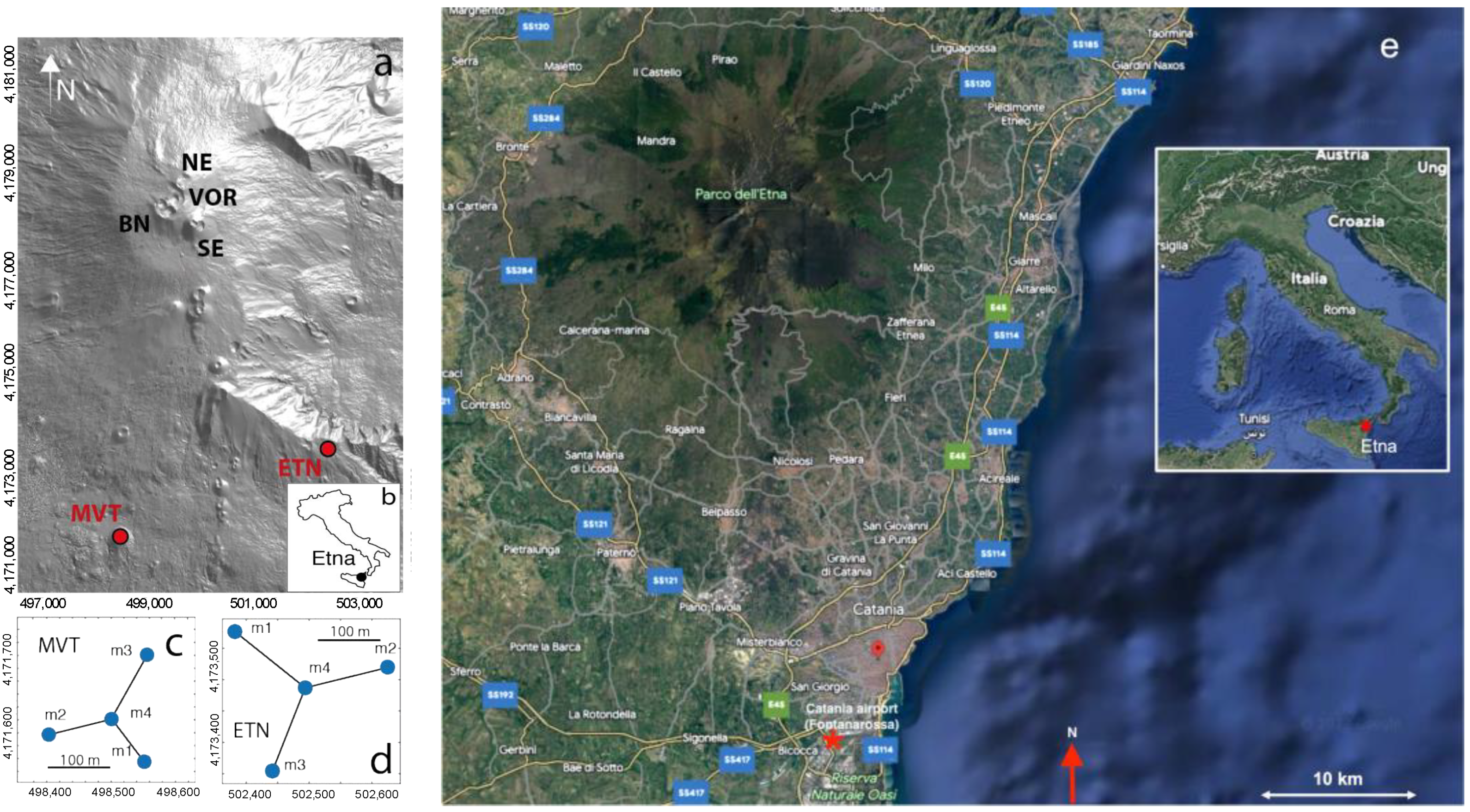

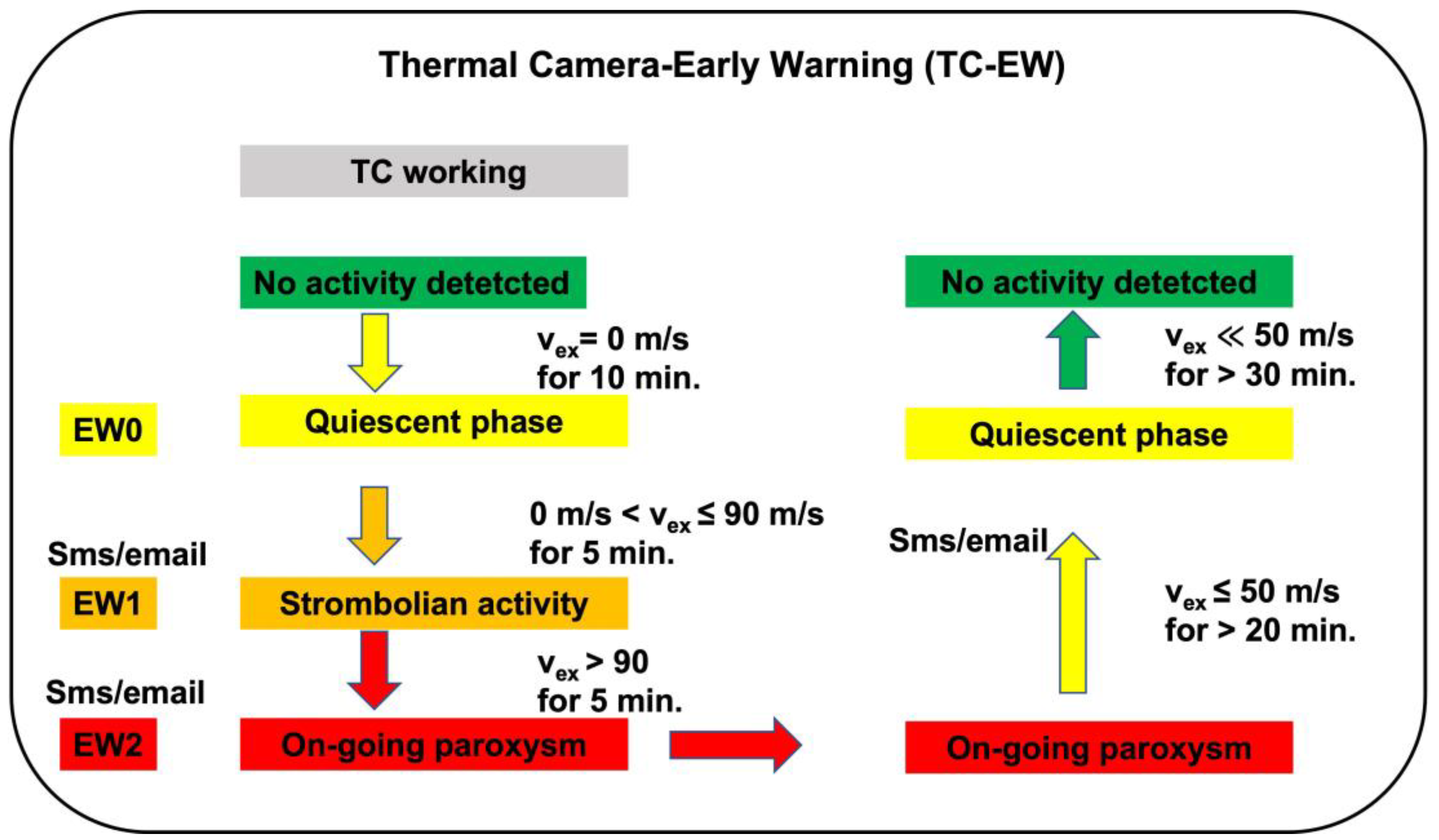

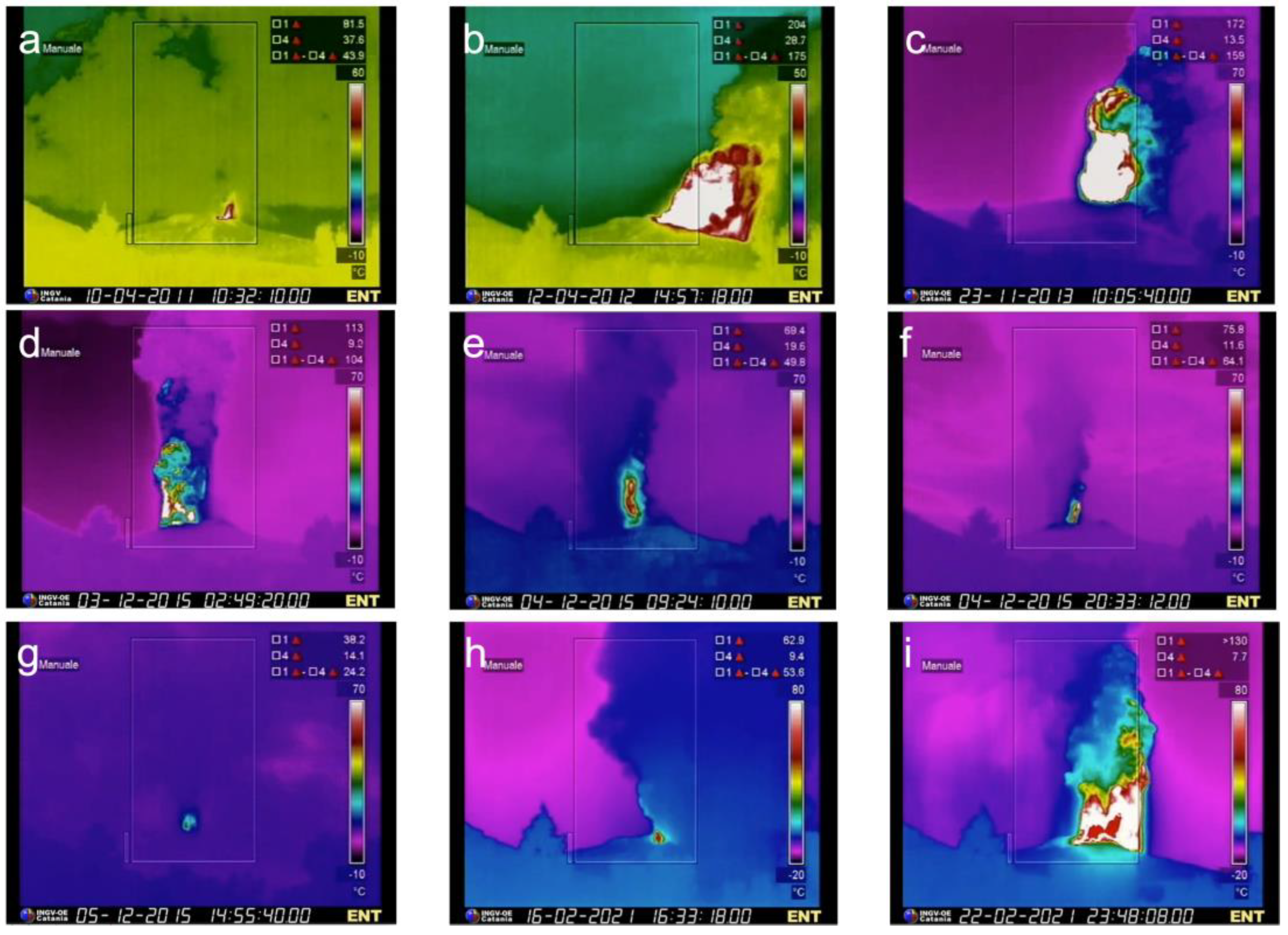

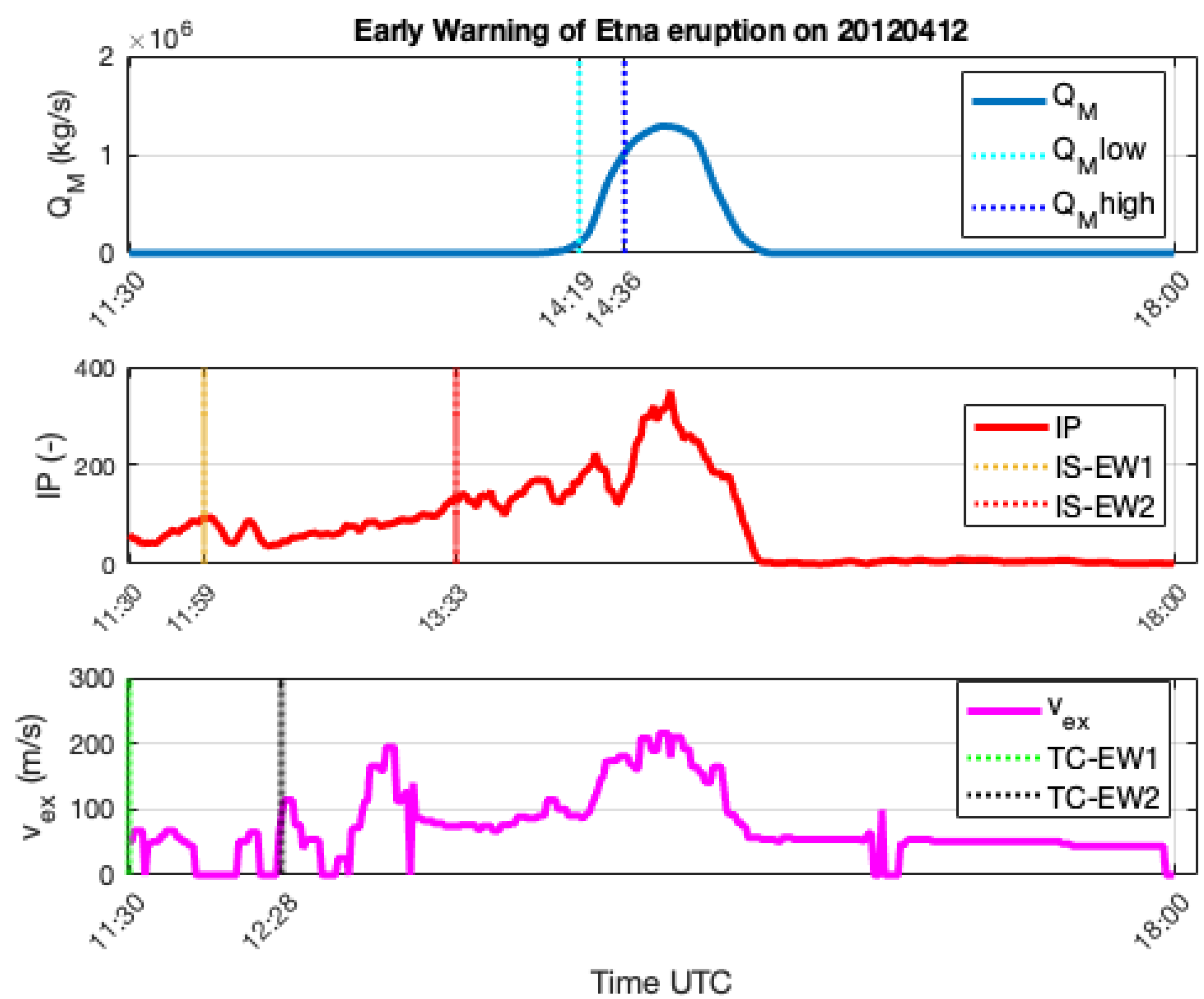
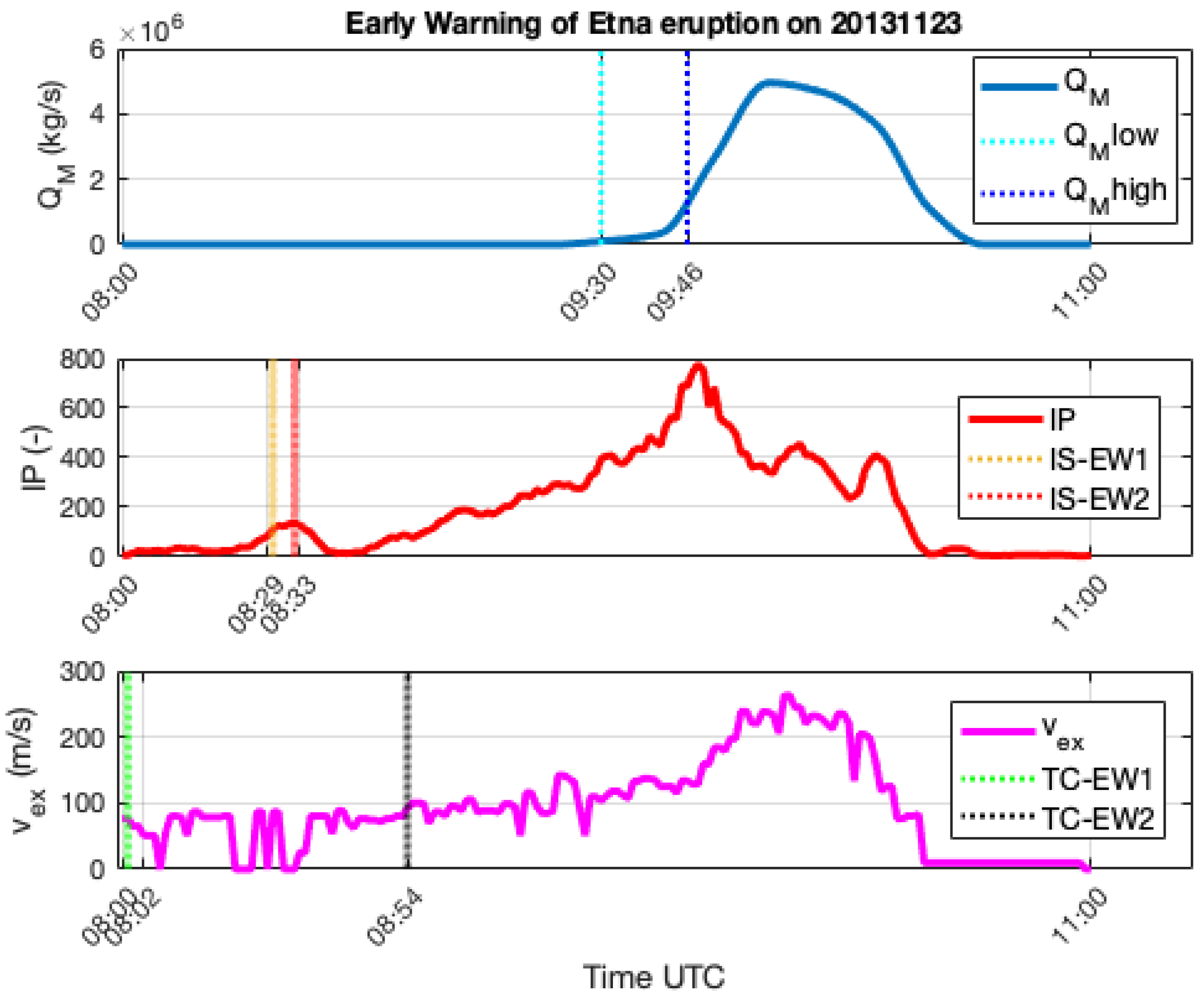

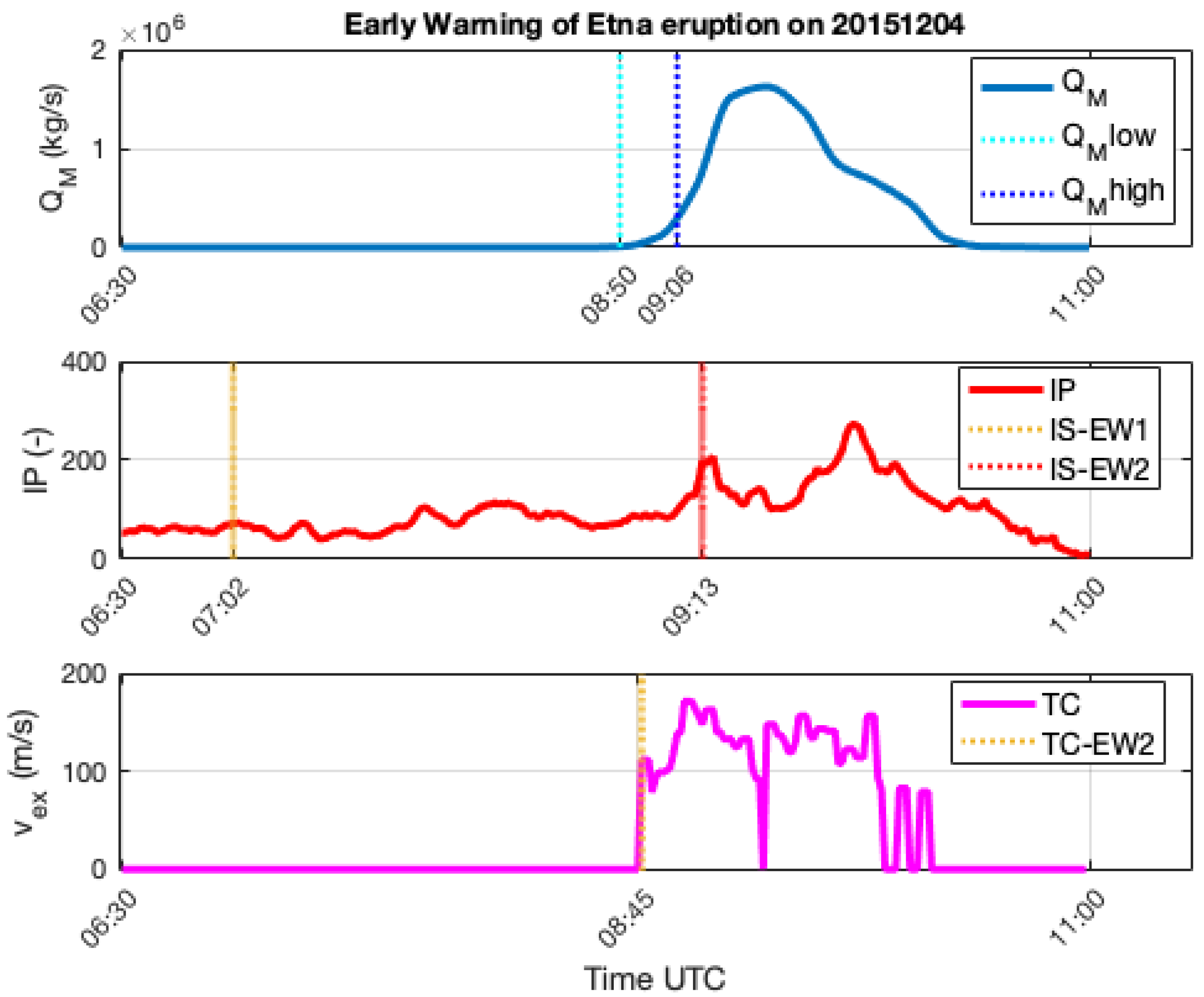

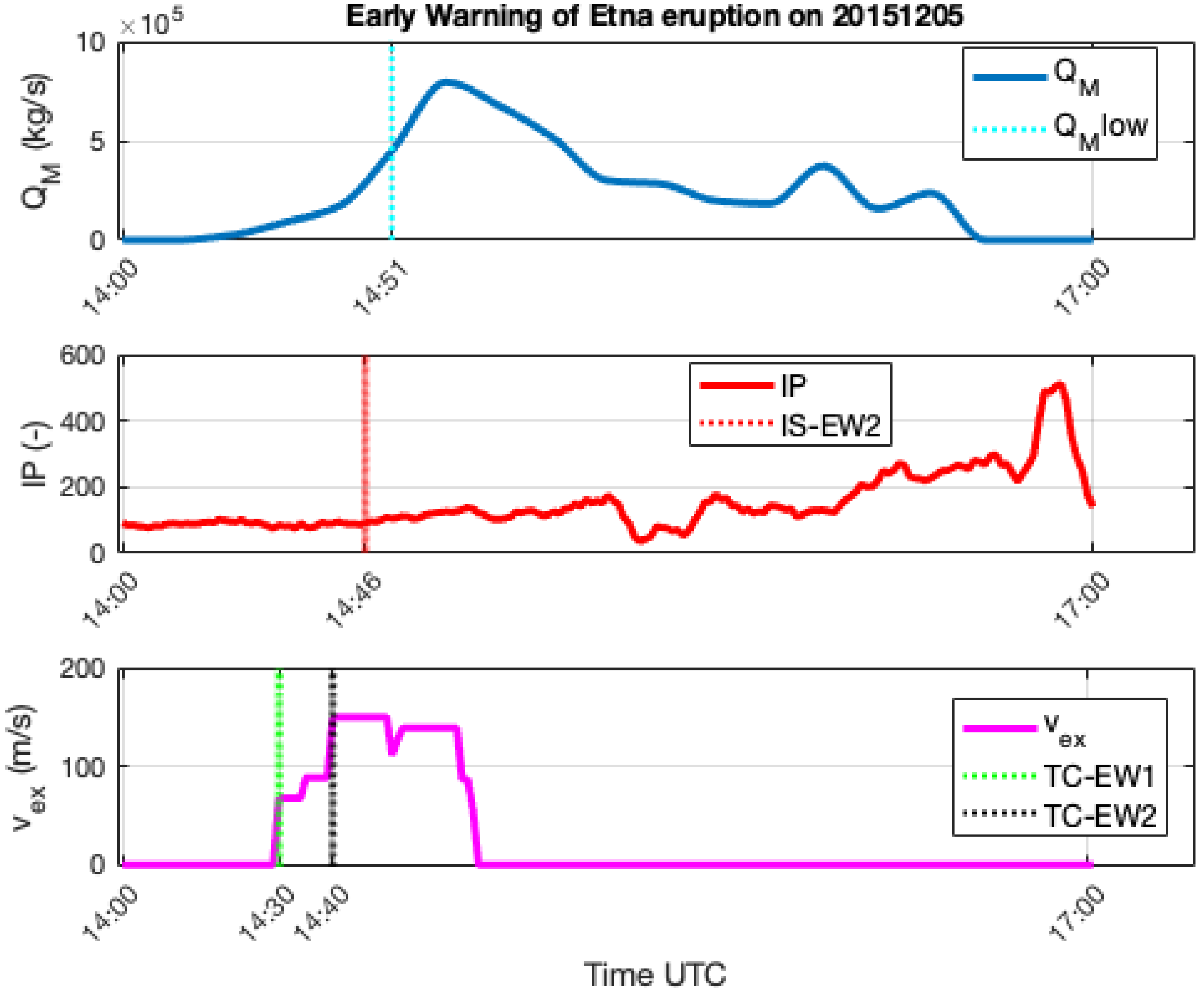
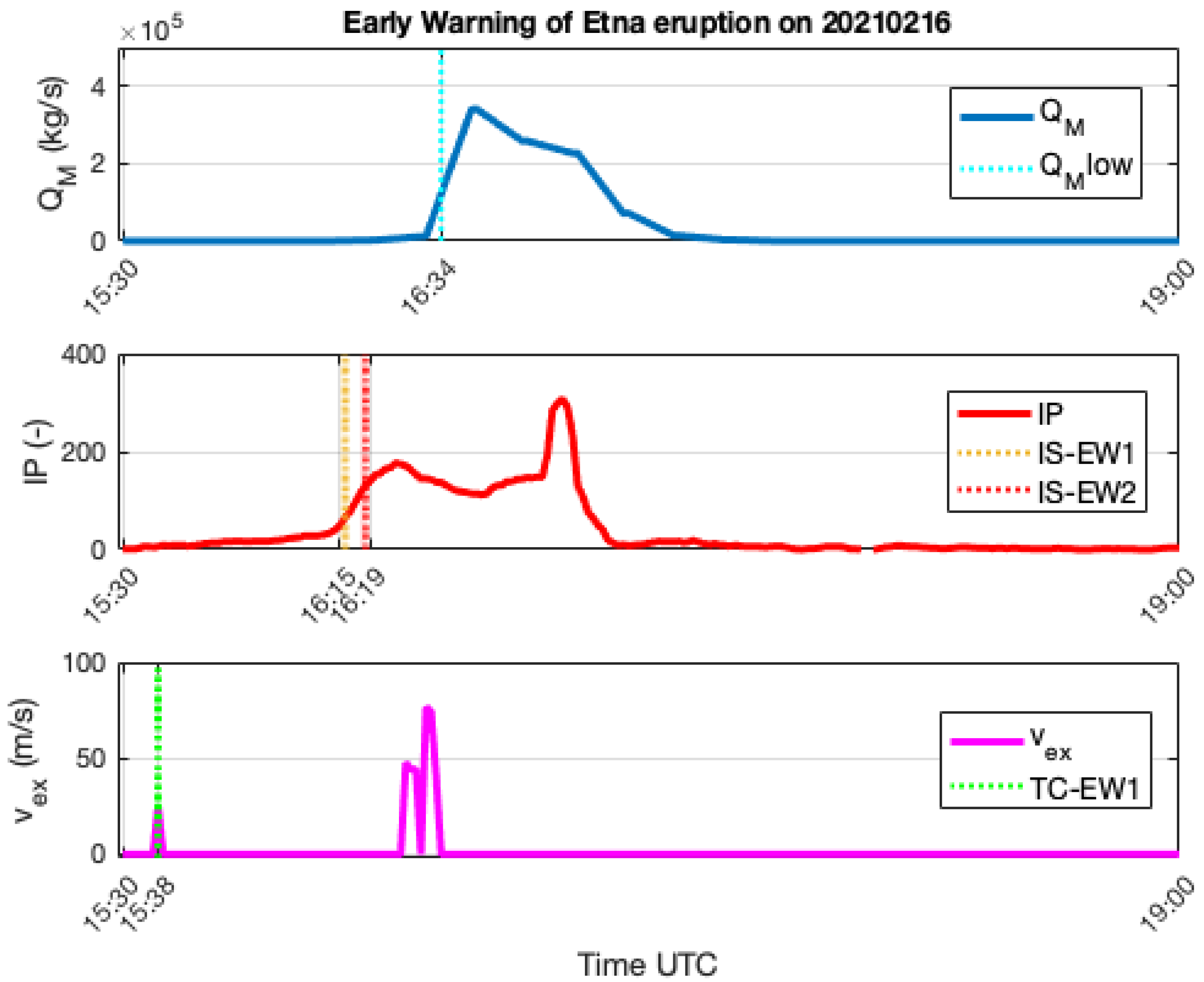


| Data | WR-QML | WR-QMH | TC-EW1 | TC-EW2 | IS-EW1 | IS-EW2 |
|---|---|---|---|---|---|---|
| 2011-04-10 | 11:25 | NA | 09:04 | 10:18 | 09:38 | 10:00 |
| 2012-04-12 | 14:19 | 14:36 | 11:30 | 12:28 | 11:59 | 13:33 |
| 2013-11-23 | 09:30 | 09:46 | 08:02 | 08:54 | 08:29 | 08:33 |
| 2015-12-03 | 02:01 | 02:23 | 01:44 | 01:53 | 02:38 | NA |
| 2015-12-04 | 08:50 | 09:06 | 08:45 | NA | 07:02 | 09:13 |
| 2015-12-04 | 20:18 | 20:37 | 20:06 | 20:32 | 07:02 | 20:30 |
| 2015-12-05 | 14:51 | NA | 14:30 | 14:40 | 07:02 | 14:46 |
| 2021-02-16 | 16:30 | NA | 16:38 | NA | 16:15 | 16:19 |
| 2021-02-23 | 23:30 | 23:44 | 18:39 | 22:47 | 21:44 | 23:11 |
| Data | Lead Time ∆t (min) | |||||
|---|---|---|---|---|---|---|
| IR-PEW1 | IR-PEW2 | IT-PEW1 | IT-PEW2 | TR-PEW1 | TR-PEW2 | |
| 2011-04-10 | 117 | NA | −34 | 18 | 141 | NA |
| 2012-04-12 | 140 | 63 | −29 | −65 | 169 | 128 |
| 2013-11-23 | 61 | 73 | −27 | 21 | 88 | 52 |
| 2015-12-03 | −37 | NA | −54 | NA | 17 | 30 |
| 2015-12-04 | 108 | −7 | 103 | NA | 5 | NA |
| 2015-12-04 | 796 | 7 | 784 | 2 | 12 | 5 |
| 2015-12-05 | 1909 | NA | 1888 | −6 | 21 | NA |
| 2021-02-16 | 15 | NA | 23 | NA | −8 | NA |
| 2021-02-23 | 106 | 33 | −185 | −24 | 291 | 57 |
| Statistic (%) | PosAlert | |||||
| 88.90 | 44.45 | 44.45 | 33.33 | 88.90 | 55.55 | |
| NegAlert | ||||||
| 11.10 | 11.10 | 55.55 | 33.33 | 11.10 | NA | |
| NotAlert | ||||||
| NA | 44.45 | NA | 33.33 | NA | 44.45 | |
Disclaimer/Publisher’s Note: The statements, opinions and data contained in all publications are solely those of the individual author(s) and contributor(s) and not of MDPI and/or the editor(s). MDPI and/or the editor(s) disclaim responsibility for any injury to people or property resulting from any ideas, methods, instructions or products referred to in the content. |
© 2023 by the authors. Licensee MDPI, Basel, Switzerland. This article is an open access article distributed under the terms and conditions of the Creative Commons Attribution (CC BY) license (https://creativecommons.org/licenses/by/4.0/).
Share and Cite
Mereu, L.; Marzano, F.S.; Bonadonna, C.; Lacanna, G.; Ripepe, M.; Scollo, S. Automatic Early Warning to Derive Eruption Source Parameters of Paroxysmal Activity at Mt. Etna (Italy). Remote Sens. 2023, 15, 3501. https://doi.org/10.3390/rs15143501
Mereu L, Marzano FS, Bonadonna C, Lacanna G, Ripepe M, Scollo S. Automatic Early Warning to Derive Eruption Source Parameters of Paroxysmal Activity at Mt. Etna (Italy). Remote Sensing. 2023; 15(14):3501. https://doi.org/10.3390/rs15143501
Chicago/Turabian StyleMereu, Luigi, Frank Silvio Marzano, Costanza Bonadonna, Giorgio Lacanna, Maurizio Ripepe, and Simona Scollo. 2023. "Automatic Early Warning to Derive Eruption Source Parameters of Paroxysmal Activity at Mt. Etna (Italy)" Remote Sensing 15, no. 14: 3501. https://doi.org/10.3390/rs15143501
APA StyleMereu, L., Marzano, F. S., Bonadonna, C., Lacanna, G., Ripepe, M., & Scollo, S. (2023). Automatic Early Warning to Derive Eruption Source Parameters of Paroxysmal Activity at Mt. Etna (Italy). Remote Sensing, 15(14), 3501. https://doi.org/10.3390/rs15143501







